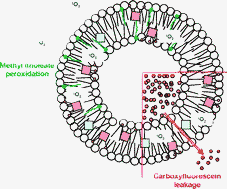Photosensitizing properties of chlorins in solution and in membrane-mimicking systems
Abstract
The photosensitizing properties of three chlorins,

Maintenance work is planned for Wednesday 1st May 2024 from 9:00am to 11:00am (BST).
During this time, the performance of our website may be affected - searches may run slowly and some pages may be temporarily unavailable. If this happens, please try refreshing your web browser or try waiting two to three minutes before trying again.
We apologise for any inconvenience this might cause and thank you for your patience.
* Corresponding authors
a
Laboratoire Acides Nucléiques et BioPhotonique (ANBioΦ), CNRS FRE 3207, Genopole Campus 1, Bât. Genavenir 8, 5 rue Henri Desbruères, Evry cedex, France
E-mail:
daniel.brault@upmc.fr
b Laboratoire Acides Nucléiques et BioPhotonique (ANBioΦ), Université Pierre et Marie Curie, Paris, France
c CNRS GDR 3049 PHOTOMED, France
d UMR 176 CNRS/Institut Curie, Institut Curie, Bât. 110, Univ. Paris-Sud, Orsay, France
e Institut Curie, Section de Recherches, Centre Universitaire, Univ. Paris-Sud, Orsay, France
f Department of Radiation Biology, Institute for Cancer Research, The Norwegian Radium Hospital, Montebello, Oslo, Norway
The photosensitizing properties of three chlorins,

 Please wait while we load your content...
Something went wrong. Try again?
Please wait while we load your content...
Something went wrong. Try again?
H. Mojzisova, S. Bonneau, P. Maillard, K. Berg and D. Brault, Photochem. Photobiol. Sci., 2009, 8, 778 DOI: 10.1039/B822269J
To request permission to reproduce material from this article, please go to the Copyright Clearance Center request page.
If you are an author contributing to an RSC publication, you do not need to request permission provided correct acknowledgement is given.
If you are the author of this article, you do not need to request permission to reproduce figures and diagrams provided correct acknowledgement is given. If you want to reproduce the whole article in a third-party publication (excluding your thesis/dissertation for which permission is not required) please go to the Copyright Clearance Center request page.
Read more about how to correctly acknowledge RSC content.
 Fetching data from CrossRef.
Fetching data from CrossRef.
This may take some time to load.
Loading related content
